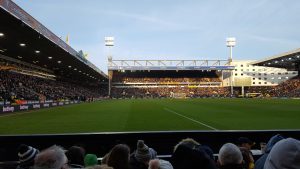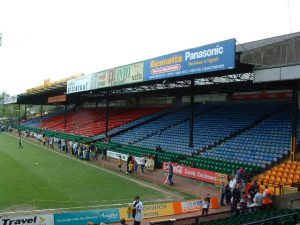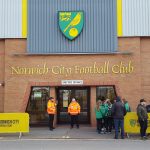Norwich City 0 Bolton Wanderers 0
Championship
Saturday 24 February 2018
The context
One of our more, er, challenging trips evoked thoughts of Man United fans on the roof and Alan Partridge on the radio. It was a bitterly cold day with wind straight off the Urals, and a good 11-hour round trip even if nothing untoward happened. But nothing would, right?
The history
Carrow Road is City’s third ground. They started off at Newmarket Road in 1902, and moved from there to The Nest in 1908. Newmarket Road was a standard suburban sports ground, essentially a pitch and a pavilion, but The Nest has gone down in history as one of the quirkiest football stadia of all time. Built into an old chalk pit, it was a glorious hotchpotch of lean-to covers and precarious terraces carved out of the chalk. The main stand was actually below some of the terraces, and for big games spectators could be seen perched on its roof.
The story is very well told here:
GONE GROUNDS – THE NEST
I have managed to uncover a variety of sources, some of which are primary, such as the photographs and eye witness accounts. I have used photographs of the ground and a brief, published, first-hand account of the Nest. I have plenty of statistics including results and attendances when Norwich played at The Nest from 1908 to 1935.
Although they had tolerated holes appearing in the pitch and injuries caused to visiting players by balls pinging back off the cliff-like concrete wall behind the far goal, in 1935 the FA finally lost patience when one corner collapsed 30 feet into the old workings below. A short time previously City had crammed an impossible-sounding 25,037 people into The Nest for a Cup-tie with Sheffield Wednesday. A new, safe ground had to be found. Quickly.
The Boulton & Paul sports ground at Carrow Road was the answer. This was near the city centre and owned by mustard magnates J & J Colman, whose own factory was next door. Famously built in just 82 days, the Canaries’ new home was the 1930s equivalent of a St Mary’s or a Riverside – a functional, accessible but unexciting design of basic stand and three sides of terraced banking. How City fans must have missed the ramshackle old Nest! Aside from club president Russell Colman, the project’s other major benefactor was Captain Evelyn Barclay. Having paid for one end to be covered, he was thanked by having it named after him.
This roof remained in place until the ground was converted to seating in the Nineties, and apart from the addition of a similar cover over the south terrace, Carrow Road retained its 1935 shape until a new stand went up at the River End in 1979.
The journey
From Lancashire, probably the longest drive of the entire 92. It certainly felt it. At stupid o’clock in the morning it was only me and Carlisle fans on the M6. I passed the first Titterington’s coach of the day just beyond Chorley, and there were more blue shirts at Stafford Services where I stopped for breakfast before picking up John in Cannock.
From there it was a good run to Norfolk in the sunshine, where we drove confusedly around the city centre, trying to park for nowt on the Yarmouth Road before giving in and paying the Lions for a spot at the Broadlands Council offices. Don’t know exactly what Lions do, but they sound fierce.
We were quickly out and away after the match and made swift progress as far as the Newmarket bypass, where we hit something hard. I suspect it was a big hole, in which case shame on you Suffolk County Council. But in any event the collision destroyed my front onside tyre, and left us in a pitch black lay-by doing what one does in this situation – looking at the damage, cursing the gods of motoring, and going “oh bollocks.”
Thus was a long day made even longer – eight hours longer, to be precise, by the time I’d been relayed home (dropping John back in Cannock en route) by no fewer than three different low-loaders. This experience included a diversion around Villa Park due to the M6 being shut, “tea” at 11pm at Keele Services in the company of pissed-off Everton fans on their way back from Watford, and a hunt around Cheshire for a Shell garage in the company of a deranged truck driver from Stoke. The final act of the day was waking the neighbours as we “quietly” unloaded the useless car at 1.30am in a temperature of -4 degrees.
The ground
Unlike Hermione Granger’s handbag, this ground is much larger outside than in. There are hotels and stuff attached to the stands and it’s surrounded by flats, bowling alleys, bistros and the like. The whole thing has the look of a scruffy area that’s been dragged upmarket, and this is indeed the case.
Until the Seventies this part of the city was heavily industrialised. The Boulton & Paul aircraft works faced the players’ entrance across Carrow Road, and the Barclay End backed onto a railway depot. Now, with Colmans about to close, just about the only unaltered part of the landscape is the River Wensum. And that’s only because you can’t build a Frankie & Benny’s on water.
We were in the lower tier behind the goal, near the front of what used to be called the River Stand. This is now the oldest one at the ground. Originally it had a terraced area in front of raised seats, and the old terrace is still there with seats simply bolted to the steps. This means odd sightlines and awkward ledges, as John found when he took a nosedive over the row in front during a rare moment of excitement.
The River Stand’s near-identical counterpart at the opposite end is actually 13 years younger and was built for seating. While the former River End was an open terrace, the Barclay Stand replaced Carrow Road’s popular kop – a moody, strut-lined cage, shared with away fans and divided top to bottom by steel fences and anti-missile netting. In 1977 the rear fence of this stand was memorably dismantled and then set on fire by Manchester United fans following a 2-1 defeat.
The modest main stand was built in 1987 to replace the original grandstand opened by Colman – or what remained following a fire three years previously that destroyed the centre section, fortunately at night-time when no-one was in it. The other side stand is bigger but blander, a 2003 construct on the site of the former South Terrace. This had gained a roof in 1959 following City’s run to the FA Cup semi-finals and was converted to seating a few years later.
Flesh and wine
The Fat Cat and Canary was next to where we parked, so we dived in there like polecats up a drainpipe. The name is dreadful but the pub wasn’t. It had a nice fuggy interior, dark wood, proper ales and proper fans. All very friendly.
There’s a distinct lack of junk food outlets nearby, and I’m increasingly coming to think food vans sanctioned by clubs are by definition just too sanitary. So eat inside the ground it was, although sadly Delia no longer does the Norwich pies (not that I imagine she ever cooked them herself). For John there was some kind of pizza/wrap deal going on, although he was mightily outraged at the difference between the picture on the wall and what he was served with. It was like Henry VIII and the Flanders Mare, but with cheese topping.
The game
This was a contest between a fancy Norwich side chasing the playoffs and an artisanical Bolton team apparently lacking any ambition beyond finishing fourth from bottom, who at one stage had all ten outfield players in the Norwich box. They wouldn’t, Norwich couldn’t: the yellow-shirted attackers foundered on the rocks of the white-shirted defence, and the only high points were James Maddison hitting the post in the first half and Moritz Leitner shooting wide soon afterwards with a chance most people in the ground would have converted.
Comedy value was provided by Bolton’s farcical ‘game management’, which led to several bookings, and a deeply ironic red card against Norwich manager Daniel Farke for kicking the ball away in irritation. “I was angry that a lot of Bolton time-wasting went unpunished and then the linesman somehow spotted a foul throw from 30 metres away”, was his reasonable explanation.
- Nor folk
- standing on the corner
- git yer programme
- Carrow Road
- Delia’s door
At many grounds the away team’s tactics would have caused a riot. But there is no anger here.
Teams
Norwich: Gunn, Reed, Zimmermann, Hanley, Lewis, Tettey (Hoolahan 80), Hernandez (Srbeny 77), Maddison, Leitner, Murphy, Oliveira. Unused subs: Pinto, Vrancic, Watkins, Raggett, McGovern.
Bolton: Alnwick, Morais, Dervite, Wheater (Flanagan 68), Beevers, Robinson, Pratley, Burke (Derik 81), Karacan, Ameobi, Le Fondre (Wilbraham 68). Unused subs: Taylor, Buckley, Howard, Clough.
Attendance: 25,475.





















